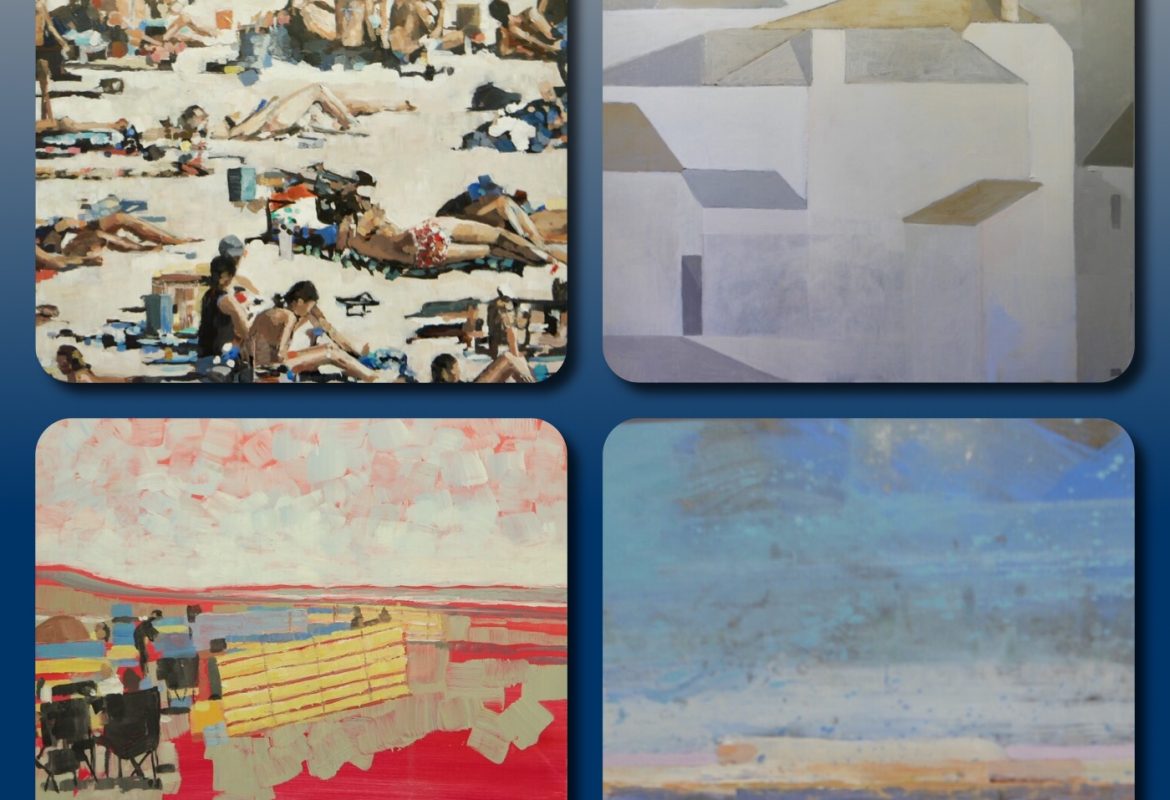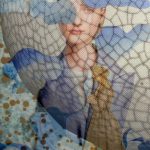Meet the Cornish Artists Zoe James and Andrew Jago
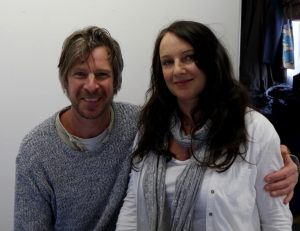
Andrew Jago and Zoe James
Last summer when I was visiting Cornwall again, I went to an exhibition at the Salthouse Gallery in St. Ives where I met the two Cornish artists Zoe James and Andrew Jago. I found their works very interesting and asked them to talk me through them, and so they did. Zoe James is working with people in different ways in her works, while Andrew Jago is working with landscapes in many ways.
Zoe James
Zoe James studied fine art and literature at Middlesex University. Her background is diverse; she has been working with music, theatre and film. In addition she has also been teaching and traveling around the world, so she is a very interesting artist. According to the artist her work explores migrations of people across shorelines and the diversity of beach life on the edge of the land. Temporary spaces are made with such passion and people interact within their defined spaces.The Art
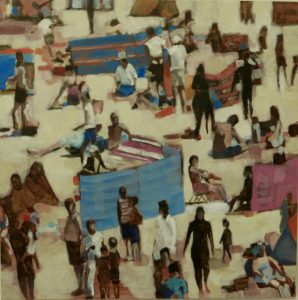
Casting Shadows
After returning to Cornwall, she has made some very interesting paintings with people as mention before. At first sight they can seem like photgraphs taking with a digital camera, but they're not. They are all paintings, and they all take place on the beach. As mention before, Zoe James is very interesting in the interaction or the less of it when it comes to people. The people in the paintings have one thing in common though; they are all enjoying a day on the beach, or...?
Looking at the picture Casting Sahdows, we find many people, but the first to catch our eyes is the blue wall. It makes a diagonal in the composition, ending more or less in the center of the picture. The form is repeated twice, and they group people into groups that they not necessarily are aware of. The colours are muted in spite of using the primary colours blue and read when it comes to the walls. The people are more or less abstracted and some are walking while others are sitting down. Looking further, we find some communication between some of them, while others seem to have none at all. The title is Casting Shadows, how to read it? This painting can be read in many ways, which we will see later.
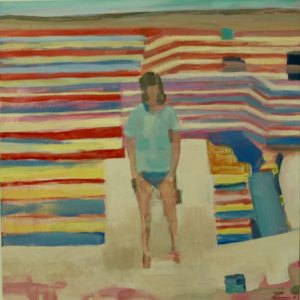
Standing on Sand
In the painting Standing on Sand we find a person all by her or himself. Maybe the person feels good, but sand is not steady, and it is easy to loose balance. Looking at the stripes; somehow it can remind us of the Norwegian painter Edvard Munch and his famous painting Skrik (Screem). But when Munch painted his Anxiety Attack, this is not what's going on here, or is it? A kind of loneliness perhaps, or is she or he just enjoying a day on the beach?
Looking at the perspective, it takes us back to the French painter Henri Matisse (1869 - 1954) that turned the three dimensional paintings, invented by Filippo Brunelleschi (1377-1446) in the Renaissance with the central perspective, back to the two dimensional perspective. It adds some naivety into the painting, an art direction from late 1800 which arose as a reaction to the established way of painting. Many artists are using naivety in paintings today as well, and it simplify the expression and in some way makes it clearer.
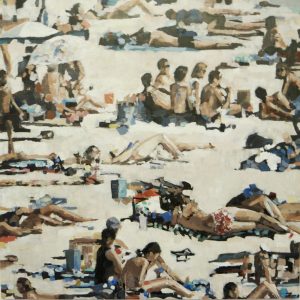
City on The Sand
Looking at the next picture; City on The Sand, we see a lot of people sitting or laying on the beach. The sun is shining and many of them are sun bathing. Others are talking together or reading a book, or even putting on sunblock. Here as well we find people in groups, but there's no wall that separates them and we find much more interaction. The light is much brighter than in the first picture too. It's like we can almost feel the sun. In the city it's crowded, and here Zoe James has taken the crowd from the city and placed them on the sand.
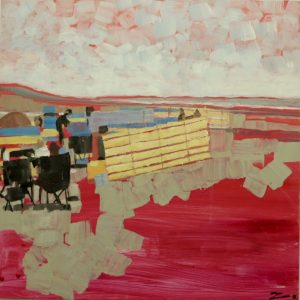
Beach Breaks
Last but not least we find a picture much more abstract and much more expressive, given by the red colour. We are still on the beach, the people are having a break, a beach break. Despite the abstraction it seems that they are barbecuing. The red colour is the colour of life, death, strong emotions etc. In this setting it is easy to read the colour as the expression of life, a good life, given by the reading of friends getting together for a break on the beach.
Reading the paintings as a whole.
According to George H. Mead (1863.1931) we socialized through interaction with other people. It is called symbolic interactionism and involves that we understand the reality through interaction with other people. With that in mind, how to read Zoe James' paintings?
There are many ways to interpret a painting, but with the symbolic interactionism as a backdrop, which I find expedient after my conversation with Zoe James about her paintings, we will try to interpret these pictures this way.
Going back to the first painting we saw that the walls, in some way, grouped the people into groups they not necessarily were aware of. Maybe we all are grouped into ways which we are not aware of? What about the people that seem to be all by themselves, is it because they don't belong here; are in a hurry or what? What about the understanding of reality?
As I mentioned before the colours are muted, but when it comes to the light it's a bit dark, and therefore we dont't get the merry feeling despite the subject. Because of this, maybe the people that don't seem to communicate in any way with others are catching our attention most.
In the next painting there's only one person, totally alone. If it is even chosen or not we don't know. Maybe we all need to be alone from time to time to clear our mind. If that is the case, we can read the borders as symbols of joy. If not we can read them as in previous mentioned Skrik. Exclusion and loneliness are feelings that way to many people have experienced. Being alone, you may ask: to what extent can they understand reality according to symbolic interactionism?
Looking at the third painting we get a much more merry feeling. The lightning is brighter than in the first picture and the people are still in groups, but in this painting we find more interaction and they seem to have chosen their own groups, being together with friends etc. In many ways we can conclude that the circumstances for understanding the reality seems very good here.
The last painting, we have already read as friends getting together in a good way, but there's an ambivalence in it. What if we read the red in another way, and what about the understanding of reality then?
As a conclusion Zoe James' paintings are very interesting, they are dealing with our interaction with other people. She makes us think and deal with it, and next time you are in a place with many people, take a look around and see how people are interact with each other, and more important; how are you interact with others?
You find Zoe James' work in Mid Cornwall Galleries and for more information click here.
Andrew Jago
Andrew Jago has a background in drawing, and in addition he has studied at Falmouth School of Art and Design. According to Jago his work is an elemental and mercurial process where his colour palette reflects the seasonal changes in Cornwall's landscape. He employs the techniques of digital photography, en plein air painting and drawing from his own imagination.
When it comes to en plein air painting it is the way the impressionists such as Monet, Renoir among others were doing late in the eighteenth century. They tried to catch the moment in a very shifting time. The colours where changed to a lighter palette; they started to use blue instead of black in the shadows for example and the composition should seem like a snapshot. No surprise that Andrew Jago has been and still in some way is, inspired by the impressionists. He mentioned Monet, Sisley and Whistler in particular. Whistler is known for the term l'art pour l'art (art for art's sake) defending the critique of his painting Nocturne. Though Whistler is more known for his realism (Whistler's Mother) in his paintings, working with Corbet, he was also working together with Manet. Manet didn't see himself as an impressionist but his famous painting Déjeuner sur l'herbe (Luncheon on the Grass) is a painting that made him to the precursor of impressionism. When it comes to Monet (1840-1926) and Sisley (1839-1899), they were impressionists.
Andrew Jago is also influenced by the Romantic artists such as Constable (1776-1837), Gainsborough (1727-1788) and Turner (1775-1851) when it comes to the sublime in nature which is a recurring motif in his work.
The Art
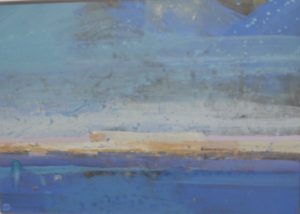
Birket Qarun C
The first paintings that captured my eyes when I approached Jago's paintings were the blue ones. He told me that in 2017 he went to Egypt together with Zoe James where he took part in a workshop run by Mohamed Abla.
Whilst there he was inspired by the desert light and blue sky as a contrast to the darker and atmospheric winter colours back home.
Looking at the painting Birket Qarun C which he painted at the time, we can see the reflection from this inspiration. In addition, we can also see the previous mentioned inspiration from the impressionism where they were using the blue colour instead of black, and the light was very important. No wonder that the experiences in Egypt had a major impact on Andrew Jago.
These paintings are very abstract but divided into several horizontal fields, almost like Mark Rothko (1903-1970) and his colour fields, but the colours are different.
Knowing that the painting was inspired by the sky and desert in Egypt, we can clearly see it, but it could also be anything else because of it's abstraction (l'art pour l'art). Blue is the colour of contemplation so therefore most of us will probably get a relaxing feeling looking at these paintings. And who doesn't need that from time to time?
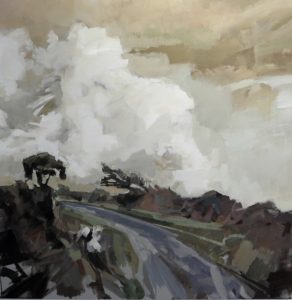
Bodmin Moor
As mention before, Andrew Jago is also a romantic painter affected by John Constable (known for The Hay Wain among others), Thomas Gainsborough (known for his portraits surrounding by landscapes) and J.M.V. Turner (known for his romantic landscape paintings which were way ahead of time).
Looking at the painting Bodmin Moor we can clearly see the impact from Constable. The palette is much darker than in the previous painting Birket Qarun C. Like in Constable's paintings we find earth tones like brown, ocher, dark green etc. Despite this, Jago's painting is more abstracted than you will find in the paintings of Constable, but Andrew Jago lives in another time as well, and being inspired by someone is a huge difference from copying someone's paintings.
The diversity in Andrew Jago's expressions is enormous. The answer he gave me as I mentioned it was that he is being inspired by so many different things; painters, places etc. etc. and it is all reflected in his works.
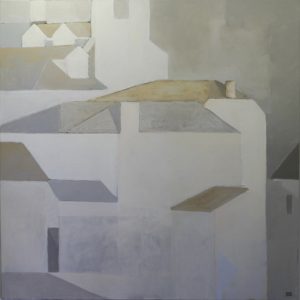
Downalong D2
Looking at the next picture; Downalong D2 it's like we have switched into cubism. Not to Picasso's or Braque's early cubism, but we find a similarity to Picasso's Houses on the Hill (1909). The colours though, are not similar, they are much more muted. They are very light grey, ochre, and almost white. The composition is in complete harmony and together with the muted colours the painting can be read as a kind of meditative expression.
This is another example of Jago's diversity in expression as mentioned before, and maybe that's what makes it so interesting, you never know what to see in an Andrew Jago exhibition.
These days Andrew Jago is currently painting for a group show at the end of June and a solo exhibition at the Salthouse Gallery in St. Ives late July.
For more information about Andrew Jago click here.
